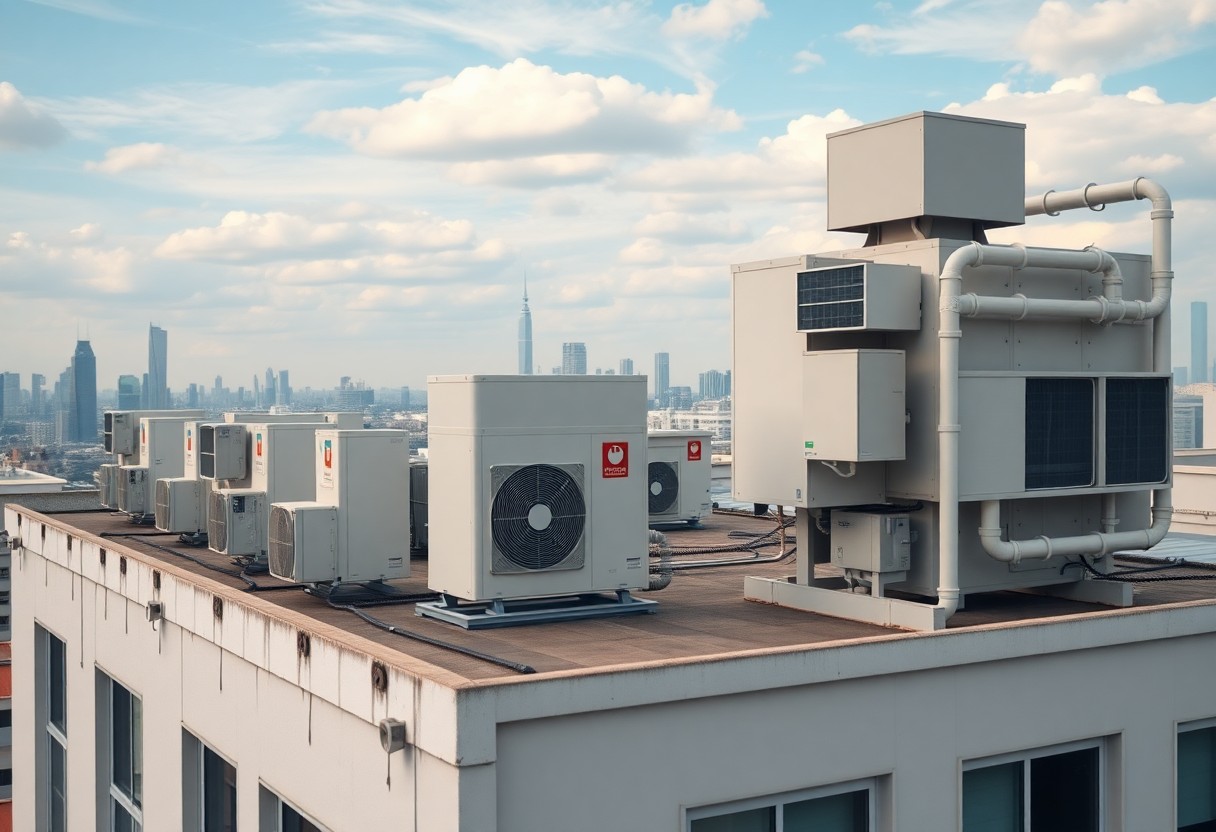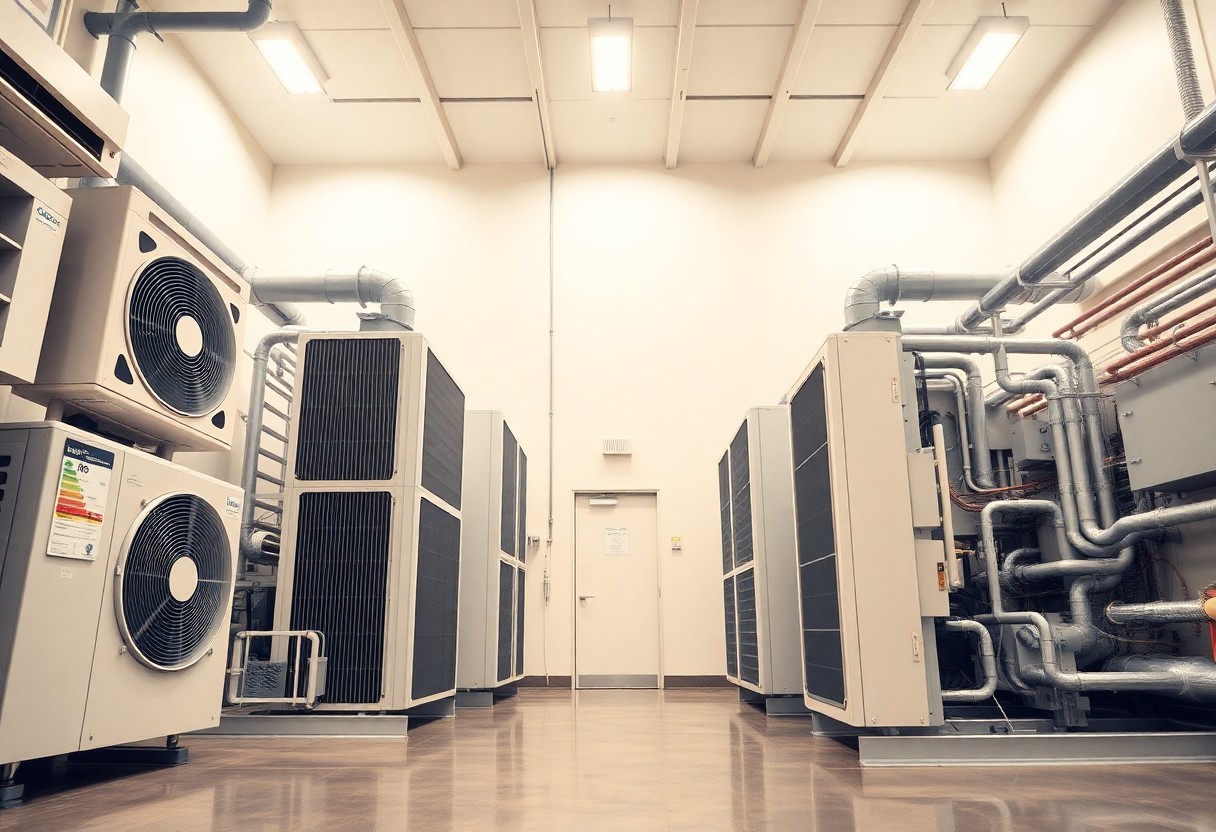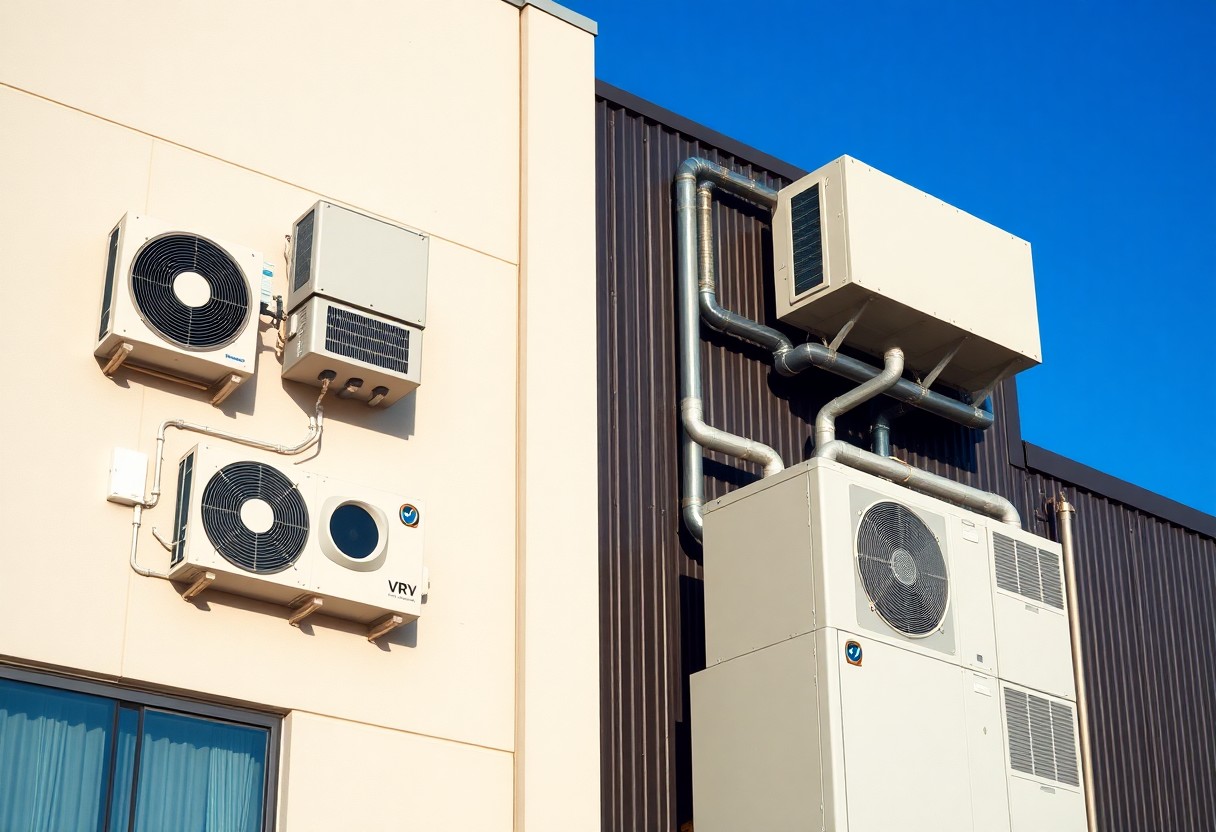VRV vs VRF Air Conditioning Systems for Commercial Buildings
You may be considering the best air conditioning solution for your commercial building, and the choice between VRV and VRF systems can be pivotal. Both technologies offer unique advantages in flexibility, efficiency, and control. Understanding their differences will help you make an informed decision tailored to your building’s specific needs and your operational goals. This post will guide you through the fundamentals of each system, enabling you to optimize your climate control strategy for improved comfort and energy savings.
Key Takeaways:
- VRF systems offer variable refrigerant flow, enabling individual zone control for energy efficiency.
- VRV systems typically refer to a specific brand of VRF technology, often emphasizing flexibility in installation.
- Both systems can provide simultaneous heating and cooling, enhancing comfort in diverse commercial spaces.
- VRF systems generally have higher upfront costs but can lead to significant long-term energy savings.
- Installation complexity is greater for VRF/VRV systems compared to traditional HVAC systems, requiring skilled technicians.

Demystifying VRV Technology
VRV (Variable Refrigerant Volume) technology represents a sophisticated approach to cooling and heating in commercial spaces. By allowing for independent control of multiple indoor units with a single outdoor unit, VRV systems enhance energy efficiency and occupant comfort. This innovative system intelligently adjusts refrigerant flow based on demand, making it an optimal choice for diverse applications in bustling commercial buildings.
Core Principles and Operational Mechanisms
VRV technology operates through a centralized outdoor condensing unit connected to multiple indoor fan coil units. The system modulates refrigerant flow dynamically, meaning that each indoor unit can run at different capacities simultaneously, catering to varying thermal loads throughout your building. This efficiency not only avoids energy waste but also minimizes installation costs by reducing the need for extensive ductwork.
Key Advantages for Large-Scale Applications
Utilizing VRV systems in large commercial buildings provides significant benefits, including flexibility, energy savings, and advanced controls. These systems support numerous indoor zones, enabling tailored climate control in different areas without compromising comfort or efficiency. The cyclic operation of VRV units ensures that energy consumption aligns more closely with actual usage, resulting in lower operational costs for your facility.
For high-traffic environments like office complexes or shopping malls, the adaptability of VRV systems becomes an asset. You can program specific cooling zones for minimization of energy use during off-peak hours, leading to an average energy savings of 30% compared to traditional systems. Additionally, the ability to heat and cool simultaneously across different zones not only enhances user comfort but also allows for strategic scheduling of HVAC operations, maximizing overall system efficiency and minimizing wear on equipment.
Unpacking VRF Systems
VRF (Variable Refrigerant Flow) systems enhance the versatility and efficiency of air conditioning in your commercial building. By using a single outdoor unit connected to multiple indoor units, VRF technology can simultaneously provide cooling and heating in different zones. This adaptability allows for varying temperature needs within the same building, accommodating various occupancy levels and space requirements without compromising comfort.
Distinct Features and Functional Advantages
Features of VRF systems include precisely controlled refrigerant flow, enhanced energy efficiency, and modular design. These systems allow for individualized climate control in different zones, reducing energy consumption while maximizing comfort. Their ability to vary refrigerant flow based on demand ensures that you use only the energy necessary for each unit, significantly lowering operational costs.
Typical Commercial Use Cases and Benefits
VRF systems are ideal for diverse commercial spaces such as hotels, office buildings, and retail environments. By providing flexible zoning and efficient temperature management, these systems enhance occupant comfort while optimizing energy use. Additionally, their compact design requires less space for installation, making them suitable for buildings with limited mechanical rooms.
In hotels, for instance, VRF systems can adjust temperatures in individual rooms based on occupancy, ensuring energy savings during unoccupied periods. In office buildings, different floors can maintain distinct climates to suit various activities, such as meeting rooms and workspaces. Retail spaces benefit from targeted cooling in display areas, enhancing product visibility and customer experience. These applications illustrate how VRF systems not only enhance comfort but also provide significant cost efficiencies across multiple commercial contexts.

Comparing Energy Efficiency: VRV vs. VRF
| Aspect | VRV | VRF |
|---|---|---|
| Seasonal Energy Efficiency Ratio (SEER) | Up to 20+ | Up to 25+ |
| Energy Consumption | Lower due to inverter-driven compressors | Enhanced efficiency through variable refrigerant flow management |
| Peak Load Reduction | Good | Excellent |
Performance Metrics and Energy Consumption
VRV systems typically showcase high SEER ratings, often exceeding 20, while VRF can reach even 25+. Their inverter technology allows for precise operation, resulting in decreased energy consumption during both peak and off-peak periods. This adaptive approach ensures that energy is utilized only when needed, leading to reduced operational costs over time.
Long-Term Cost Savings Analysis
Your long-term savings play a significant role in choosing between VRV and VRF systems. While the initial investment might be higher for VRF systems, their superior energy efficiency and advanced management capabilities often lead to lower utility bills and maintenance costs over the lifespan of the equipment. This translates to a more favorable total cost of ownership for your commercial building.
Over a typical operational lifespan of 15 to 20 years, the energy savings from VRF can accumulate to substantial amounts, sometimes reaching up to 30% compared to traditional systems. For instance, a commercial building using a VRF system may save around $50,000 annually in energy costs, alongside reduced maintenance expenses. By analyzing your specific energy rates and operational conditions, these figures can help you understand the financial benefits and justify the initial investment in VRF technology.
Installation Nuances: What to Consider
Determining the optimal installation for either a VRV or VRF system involves careful consideration of various factors. Factors such as building size, habitat diversity, and local climate should influence your choice. The specific requirements for ductwork, refrigerant piping, and associated electrical systems also play significant roles. Each system’s complexity may also dictate whether specialized installation professionals are needed, thus affecting overall project timelines and outcomes.
Space and Infrastructure Requirements
Your building’s layout and available space can significantly impact the installation of VRV or VRF systems. VRV systems typically require less indoor space due to their compact design and fewer components. On the other hand, VRF systems may need larger outdoor units and additional support structures, depending on the configuration and system capacity. Assess whether your infrastructure can accommodate the necessary equipment without imposing on tenant space.
Installation Costs and Maintenance Considerations
Installation costs vary between VRV and VRF systems based on system complexity and required infrastructure adjustments. Generally, VRF systems have higher upfront costs due to extensive piping and equipment needs. However, both systems typically offer lower maintenance requirements than traditional units, which can translate to long-term savings. Assess potential operational efficiencies and maintenance schedules when calculating total cost of ownership.
For a complete understanding of installation costs and maintenance, consider your system’s life expectancy and energy savings. VRF systems, while initially pricier, can offer substantial energy efficiency, reducing utility bills over time. Maintenance considerations include regular inspections of refrigerant levels and component checks, which can be integrated into scheduled property maintenance routines. Comparing projected operational costs alongside initial investments helps illustrate the overall financial picture, guiding your decision-making process.
Strategic Considerations for Decision-Makers
As you evaluate air conditioning systems, focusing on your unique operational needs and future goals is important. Assessing compatibility with existing infrastructure, energy efficiency targets, and maintenance capabilities will guide you toward the best choice between VRV and VRF solutions. Additionally, consider your building’s design and occupancy patterns, as these factors significantly influence system performance and cost-effectiveness.
Comparative Analysis of Initial Investment vs. Lifecycle Costs
Initial investment in VRV systems typically ranges from $15,000 to $50,000 for a medium-sized commercial building, while VRF systems might range from $25,000 to $70,000. However, lifecycle costs reveal that VRF systems can offer up to 30% savings on energy bills over their lifespan, leading to lower total ownership costs despite the higher upfront costs.
Initial Investment vs. Lifecycle Costs
| System Type | Cost Overview |
|---|---|
| VRV | $15,000 – $50,000 initial; lower lifecycle costs |
| VRF | $25,000 – $70,000 initial; potentially 30% energy savings |
Future-Proofing Your Commercial HVAC System
Investing in advanced HVAC technology is vital for future-proofing your building. VRF systems, with their adaptability to incorporate smart technology and IoT integration, provide the flexibility your business needs as energy standards evolve. This adaptability not only meets current compliance but also prepares you for future mandates that may arise, ensuring long-term operational efficiency.
Your choice of HVAC system should anticipate advancements in technology and sustainability. For example, VRF systems adapt seamlessly to new energy-efficient refrigerants, while VRV systems may require more significant upgrades for compliance with future regulations. By choosing a system that prioritizes technology integration, you ensure your investment remains relevant and efficient for years to come, minimizing disruption and maximizing savings. This strategic foresight not only enhances your energy management but also aligns with your long-term sustainability goals.
To wrap up
Presently, as you consider air conditioning options for your commercial building, understanding the differences between VRV and VRF systems is necessary. VRF systems offer flexibility with variable refrigerant flow tailored to your specific needs, while VRV systems provide high efficiency and multi-zone control. Your choice will depend on factors such as space requirements, energy efficiency goals, and budget constraints. By weighing these aspects, you can make an informed decision that best suits your operational demands and enhances your building’s comfort and energy performance.
FAQ
Q: What is the primary difference between VRV and VRF systems?
A: VRV (Variable Refrigerant Volume) and VRF (Variable Refrigerant Flow) are vitally the same technology, with VRV being a brand name created by Daikin. Both systems allow for varying refrigerant flow to multiple indoor units from a single outdoor unit, optimizing energy efficiency.
Q: What are the efficiency benefits of using VRV/VRF systems in commercial buildings?
A: VRV/VRF systems provide energy efficiency through their ability to modulate refrigerant flow based on real-time load requirements, reducing energy consumption. They can also recover heat from one area and provide it to another, enhancing overall efficiency.
Q: How do installation and maintenance differ between VRV and VRF systems?
A: Installation of both systems typically requires specialized skills, but VRV systems might have more complex configurations due to proprietary components. Maintenance for both systems involves regular checks on refrigerant levels, airflow, and control systems to ensure optimal performance.
Q: Are VRV/VRF systems suitable for all types of commercial buildings?
A: Yes, VRV/VRF systems are versatile and can be used in various commercial settings, including offices, retail spaces, and hotels, as they can efficiently manage multiple zones with different heating and cooling requirements.
Q: What is the lifespan of VRV/VRF air conditioning systems?
A: The typical lifespan of VRV/VRF systems ranges from 15 to 20 years, depending on maintenance practices, environmental conditions, and usage patterns. Regular maintenance can help extend their operational lifespan.
